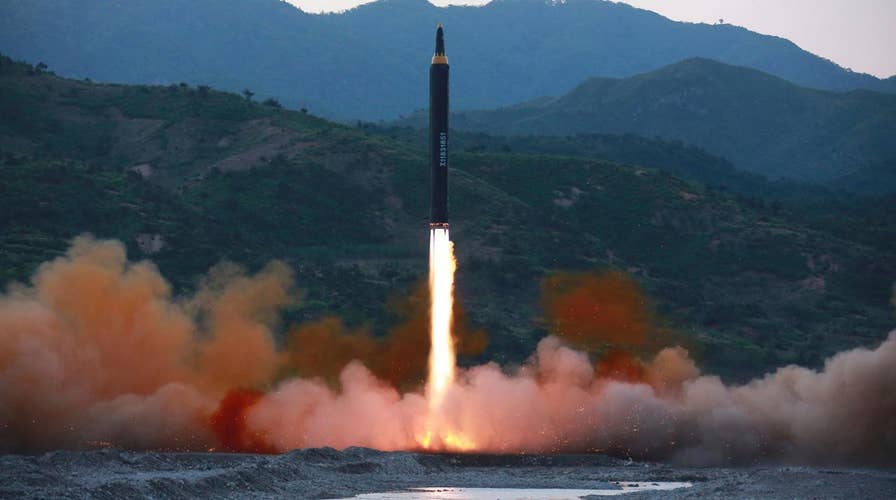Fallout from North Korea's 'record-setting' missile test
Lucas Tomlinson reports from the Pentagon
North Korea said Monday that the medium-range strategic missile it tested over the weekend was "capable of carrying a large-size heavy nuclear warhead."
Dictator Kim Jong Un was said to have witnessed the test early Sunday and "hugged officials in the field of rocket research, saying that they worked hard to achieve a great thing," according to the communist dictatorship's official Korean Central News Agency.
The claim, if confirmed, would mark another big step forward in the country's escalating efforts to field a nuclear-tipped missile capable of reaching the U.S. mainland. Outside experts have said they do not believe the rogue nation can do that yet, but each new test may push them closer to that goal.
The missile flew 1,245 miles above the surface of the Earth this weekend according to U.S., South Korean and Japanese officials. For context, the International Space Station orbits at roughly 240 miles above the Earth. If launched on a “normal” trajectory, officials estimate the KN-17 missile would be able to hit targets 2,800 miles away, including Guam, where U.S. troops and Air Force bombers are stationed.
North Korea may have pioneered a new engine for its ballistic missiles -- an engine the rogue nation first displayed in March, according to Jeffrey Lewis, a missile proliferation expert at the Middlebury Institute in Monterey, Calif.
"North Korea showed off a new engine we had never seen," Lewis said. "In other words, this is a big breakthrough for the North Koreans."
Earlier Sunday, officials told Fox News that the U.S. military believes Pyongyang launched a KN-17 medium-range ballistic missile — the first successful test in four attempts for the Pyongyang regime. The missile flew for four minutes longer than any previous ballistic missile test in the history of the communist regime, U.S. officials said.
The KN-17 is a single-stage, liquid-fueled missile -- not the three stage, solid-fuel missile that North Korea successfully tested back in February, which caused more concern among Pentagon officials.
UNITED STATES ‘MONITORING’ CLAIM MISSILE COULD CARRY NUCLEAR WARHEAD
North Korea made three attempts last month to launch the KN-17, but failed each time. Officials have said they believe North Korea aims to use the missile to target ships.
The missile flew for half an hour and reached an unusually high altitude before landing in the Sea of Japan, the South Korean, Japanese and U.S. militaries said.
The latest test came a few days after the CIA opened a new "mission center" to study the nuclear and missile threat from North Korea.
Missile experts initially thought the rogue communist regime had tested a new type of intermediate-range ballistic missile, but U.S. officials told Fox News that is not the assessment from the U.S. Pacific Command and U.S. Strategic Command. A U.S. official told Fox News the missile splashed down about 60 miles south of Russia’s Vladivostok region and approximately 250 miles from Japanese shores.
UNITED STATES WILL 'TIGHTEN THE SCREWS' ON NORTH KOREA, HALEY SAYS
Japanese officials said the missile flew for about 30 minutes, traveling about 500 miles and reaching an unusually high altitude of 1,240 miles. The South Korean military said the missile traveled about 430 miles.
On February 12, North Korea successfully tested a KN-15 from a mobile launcher using a solid-fuel engine, causing concern among Pentagon officials. The KN-15 can be launched with five minutes' notice from a concealed location — a concerning advancement by the communist regime for senior Pentagon officials.
According to the South Korean military, the launch site used Sunday was the same one used on February 12 — the first North Korean ballistic missile test during the Trump administration, launched while President Trump hosted Japan’s Prime Minister Shinzō Abe at his Mar-a-Lago Club in Florida.
The launch jeopardizes new South Korean President Moon Jae-in's willingness for dialogue with the North, and came as U.S., Japanese and European navies gather for joint war games in the Pacific. Moon convened an emergency session of his national security council Sunday, shortly after the missile test.
"The president expressed deep regret over the fact that this reckless provocation ... occurred just days after a new government was launched in South Korea," senior presidential secretary Yoon Young-chan said. "The president said we are leaving open the possibility of dialogue with North Korea, but we should sternly deal with a provocation to prevent North Korea from miscalculating."
Moon, South Korea's first liberal leader in nearly a decade, said as he took his oath of office last week that he'd be willing to visit the North if the circumstances were right.
The U.N. Security Council said Sunday it will hold urgent consultations on North Korea's latest ballistic missile test at the request of the United States, Japan and South Korea. Uruguay holds the council presidency this month and its U.N. Mission announced the closed consultations will be held on Tuesday afternoon.
The Security Council has adopted six increasingly tougher sanctions resolutions against North Korea
Trump's administration has called North Korean ballistic and nuclear efforts unacceptable, but he has swung between threats of military action and offers to talk as it formulates a policy.
On Saturday, a top North Korean diplomat in charge of U.S. relations, Choe Son Hui, told reporters in Beijing that Pyongyang would be willing to meet with the Trump administration for negotiations "if the conditions are set." She did not elaborate.
The launch came as troops from the U.S., Japan and two European nations gather near Guam for drills that are partly a message to North Korea. The USS Carl Vinson, an aircraft supercarrier, is also engaging with South Korean navy ships in waters off the Korean Peninsula, according to Seoul's Defense Ministry.
Fox News’ Lucas Tomlinson and The Associated Press contributed to this report.

